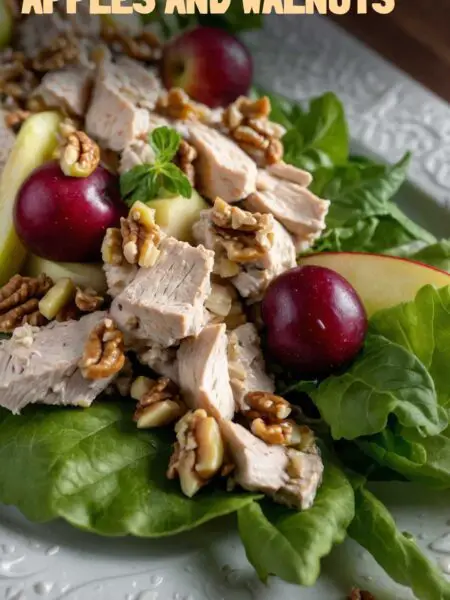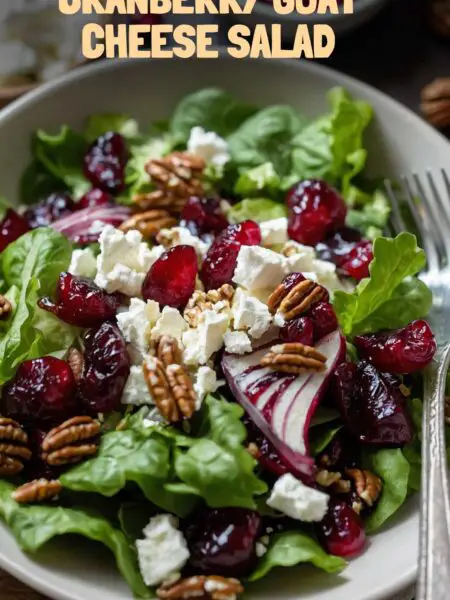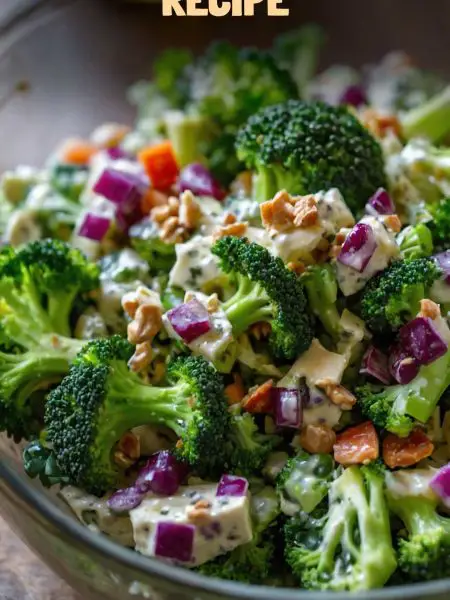Before we dive into the details of making an Israeli couscous salad, let’s chat about what to pair with it. This dish is wonderfully versatile and makes a stellar addition to any meal. Here are some ideas:
1. Grilled Chicken or Fish: The light and fresh flavors of the salad complement grilled meats beautifully. Consider a lemon-herb chicken or simply seasoned salmon.
2. Roasted Vegetables: Spice up your plate with some roasted veggies. Carrots, zucchini, or bell peppers can add another dimension to your meal.
3. Pita Bread and Hummus: For a touch of Mediterranean flair, serve the salad alongside warm pita and creamy hummus.
4. Feta or Goat Cheese: If you want to up the cheese game, crumbled feta or goat cheese can elevate the salad further.
5. Wine Pairing: A crisp white wine like Sauvignon Blanc or a light-bodied red like Pinot Noir can be a delightful complement.
Now, let’s get into the heart of the dish.
Growing up, I had a fascination with food that transcended mere sustenance. It was about the experience—the colors, the aromas, and the eventual bite that brought everything together. Israeli couscous salad became one of my favorites, especially during the summer months when fresh veggies and herbs were in abundance. This salad is a celebration of flavors and textures, making it a delight for dinner parties or casual BBQs.
Each time I prepare this dish, I’m reminded of the vibrant Mediterranean markets where everything is fresh and bursting with color. Through a few simple steps, I’ll guide you on how to recreate this refreshing salad.

You Might Also Like These Recipes!
- Beet Salad
- How To Make Cranberry Goat Cheese Salad Recipe
- Chicken salad with apples and walnuts Recipe
What is Israeli Couscous Salad?
Israeli couscous, or “pearl couscous,” is a type of pasta made from semolina flour; its tiny spheres have a delightful chewy texture. Unlike traditional couscous, which is made from crushed durum wheat, Israeli couscous has a more substantial bite, making it ideal for salads.
An Israeli couscous salad typically combines the pasta with an array of colorful vegetables, herbs, and a zesty dressing, resulting in a dish that’s as nourishing as it is delicious. It’s the perfect meal for warm weather and can be enjoyed as a side or a stand-alone dish.
What is the Flavor Profile of This Dish?
Let’s explore flavors. This salad embodies a balance of tangy, savory, and fresh elements. The feta cheese contributes a salty creaminess that pairs well with the sweetness of cherry tomatoes and the crunch of cucumbers. Fresh herbs like parsley or basil add a burst of freshness, while a simple dressing of olive oil and lemon juice gives a bright, zesty finish.
The contrast in textures—from the chewy couscous to the crisp veggies and creamy cheese—keeps each bite interesting. It’s a dish that engages your palate while keeping your taste buds guessing.
What Makes This Recipe Different From Other Israeli Couscous Salad Recipes?
While you might find many Israeli couscous salad recipes, this one stands out for several reasons. First, it incorporates a variety of textures and flavors that play well together in any setting. I combine classic ingredients like feta and olives with unique add-ins like toasted pine nuts for crunch and a sprinkle of fresh herbs that infuse the dish with excitement.
Additionally, I emphasize using good-quality olive oil, which serves as the backbone of the dressing. The flavor enhances and ties everything together, elevating the dish into something memorable.
Ingredients You’ll Need
Now, let’s gather our ingredients. This recipe is simple, yet it requires fresh and vibrant components. Here’s what you need to prepare:
- 2 tablespoons lemon juice (from about one lemon)
- ½ cup diced red onion (from about one half of a medium onion)
- Kosher salt and black pepper (as needed)
- 1 cup kalamata olives, pitted and sliced in half
- 2 tablespoons toasted pine nuts (optional)
- 4 oz. feta cheese, crumbled
- 2 cups diced cucumber (from about one large cucumber, peeled and/or seeded if desired)
- 4 tablespoons extra-virgin olive oil, divided, plus more if needed
- 8 oz. Israeli (Pearl) Couscous
- ¼ – ½ cup chopped fresh herbs (mint, parsley, basil, and/or dill work well here)
- 1 pint cherry tomatoes, halved (about 1 cup)
- 1 small clove garlic, minced
Step by Step Directions
Step 1: Cook the Couscous
To start, bring a large pot of salted water to a boil. Add the Israeli couscous and cook according to the package directions, generally about 8–10 minutes, until they are tender but still have a nice bite. Once cooked, drain the couscous, rinsing it under cold water to halt the cooking process. This helps maintain its firm texture.
Step 2: Prepare the Vegetables and Herbs
While the couscous cooks, chop the cucumber and halve the cherry tomatoes. Don’t forget the red onion!
Dice it finely so that its flavor distributes evenly throughout the salad. You can also mince the garlic at this point. Chop your fresh herbs, discarding any tough stems—fresh herbs will lift the whole dish.
Step 3: Make the Dressing
Grab a small bowl and combine the lemon juice, olive oil, minced garlic, salt, and pepper. Whisk these ingredients together until emulsified.
This dressing is where the magic happens. Use a good quality extra-virgin olive oil; its flavor is essential for balancing all the ingredients.
Step 4: Combine Ingredients
In a large bowl, combine the cooked couscous, diced cucumber, halved cherry tomatoes, olives, and red onion. Add in the crumbled feta and toasted pine nuts for added texture. Pour the dressing over the salad, tossing gently to combine everything evenly.
Step 5: Season and Garnish
Taste your salad. This is the moment to adjust seasoning. If it needs a bit more brightness, add another squeeze of lemon juice. Sprinkle in your chopped herbs and fold them in gently with a spatula or large spoon, ensuring everything gets nicely coated.
Step 6: Chill and Serve
For the best flavor, cover the salad and let it chill in the refrigerator for at least 30 minutes. This allows the flavors to meld beautifully. When ready to serve, give it one final stir, and enjoy the burst of fresh tastes!
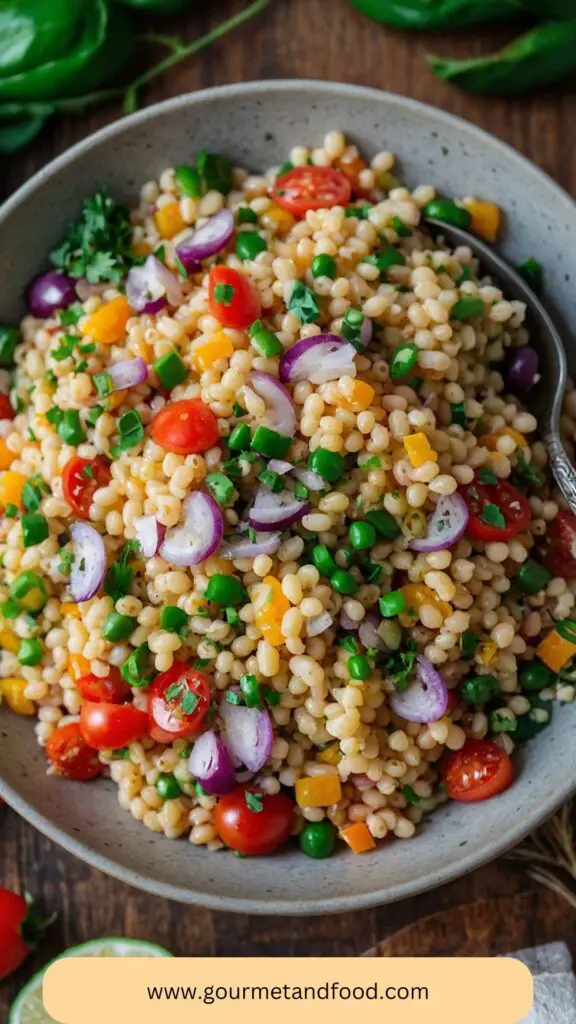
Tips On Making Israeli Couscous Salad
Here are some additional tips that can elevate your salad-making game:
Experiment with Vegetables: Consider adding various vegetables based on your preference. Roasted bell peppers or artichoke hearts can add a unique twist.
Add Protein: If you’re looking to make this a complete meal, grilled chicken and shrimp work well.
Make It Ahead: The salad develops delicious flavors with time, making it perfect for meal prep.
Store Properly: If you have leftovers, store them in an airtight container in the fridge for up to three days.
Serve for Any Occasion: Whether it’s a potluck, picnic, or family dinner, this salad is a crowd-pleaser.
Nutrition Information
Here’s a glance at the nutrition you get from this salad:
- Calories: Approximately 250 calories per serving
- Protein: 8 grams
- Carbohydrates: 30 grams
- Fat: 10 grams
- Fiber: 3 grams
This makes it a filling yet health-conscious choice that doesn’t skimp on goodness.
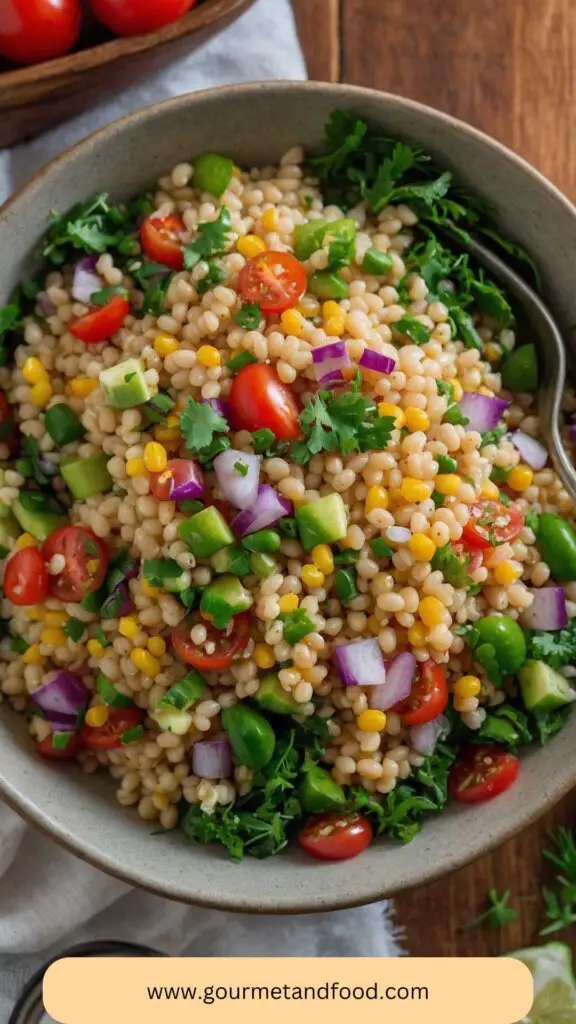
How Can I Store This Israeli Couscous Salad Recipe?
When it comes to leftovers, proper storage is key. Keep your salad in an airtight container in the refrigerator. It can last for about three days. However, note that the texture might change as time goes on. If you plan to store it for a while, you may want to keep the dressing separate and mix it in just before serving to maintain freshness.
Substitute Options for Ingredients
Sometimes, ingredients may not be available in your kitchen. Here are some substitution options you might consider:
Couscous Alternatives: You can use quinoa or farro if you’re looking for a gluten-free option.
Olives: Instead of kalamata olives, green olives or even capers can work, adding a different flavor dimension.
Feta Cheese: If you don’t have feta on hand, try cottage cheese or nutritional yeast for a dairy-free option.
Fresh Herbs: If you lack fresh herbs, dried herbs can be used as well; just remember to use less since dried herbs have a more concentrated flavor.
Frequently Asked Questions
Can I use regular couscous instead of Israeli couscous?
Yes, you can substitute regular couscous, but the texture will vary. Israeli couscous is larger and chewier, while traditional couscous is fluffier.
Is this salad vegan-friendly?
To make the salad vegan, simply omit the feta cheese or substitute it with vegan cheese options or avocado for creaminess.
How can I make this dish gluten-free?
Use gluten-free Israeli couscous or replace it with quinoa or riced cauliflower for a hearty gluten-free dish.
What’s the best way to serve this salad?
It’s best served cold, making it perfect for a picnic or potluck. Garnish with extra herbs or a sprinkle of nuts to make it visually appealing.
Can I freeze this salad?
Freezing is not recommended as the ingredients may become mushy upon thawing. It’s best enjoyed fresh or stored for a few days in the fridge.
Conclusion
Making Israeli couscous salad is a straightforward and rewarding process that brings joy and flavor to any table. With fresh ingredients and a zesty dressing, it’s a gourmet dish that anyone can prepare with just a little time and effort.
Whether you’re gearing up for a summer gathering or simply seeking to brighten your meal prep routine, this salad ticks all the boxes. Its versatility can accommodate various dietary preferences while packing a nutritious punch. So, the next time you find yourself in the kitchen, let this salad be your canvas, and feel free to create and customize it to your heart’s content. Enjoy!
You Might Also Like These Latest Recipes!

Israeli Couscous Salad – Gourmet And Food
Description
Growing up, I had a fascination with food that transcended mere sustenance. It was about the experience—the colors, the aromas, and the eventual bite that brought everything together. Israeli couscous salad became one of my favorites, especially during the summer months when fresh veggies and herbs were in abundance. This salad is a celebration of flavors and textures, making it a delight for dinner parties or casual BBQs.
Ingredients
Instructions
Step 1: Cook the Couscous
-
To start, bring a large pot of salted water to a boil. Add the Israeli couscous and cook according to the package directions, generally about 8–10 minutes, until they are tender but still have a nice bite. Once cooked, drain the couscous, rinsing it under cold water to halt the cooking process. This helps maintain its firm texture.
Step 2: Prepare the Vegetables and Herbs
-
While the couscous cooks, chop the cucumber and halve the cherry tomatoes. Don’t forget the red onion!
-
Dice it finely so that its flavor distributes evenly throughout the salad. You can also mince the garlic at this point. Chop your fresh herbs, discarding any tough stems—fresh herbs will lift the whole dish.
Step 3: Make the Dressing
-
Grab a small bowl and combine the lemon juice, olive oil, minced garlic, salt, and pepper. Whisk these ingredients together until emulsified.
-
This dressing is where the magic happens. Use a good quality extra-virgin olive oil; its flavor is essential for balancing all the ingredients.
Step 4: Combine Ingredients
-
In a large bowl, combine the cooked couscous, diced cucumber, halved cherry tomatoes, olives, and red onion. Add in the crumbled feta and toasted pine nuts for added texture. Pour the dressing over the salad, tossing gently to combine everything evenly.
Step 5: Season and Garnish
-
Taste your salad. This is the moment to adjust seasoning. If it needs a bit more brightness, add another squeeze of lemon juice. Sprinkle in your chopped herbs and fold them in gently with a spatula or large spoon, ensuring everything gets nicely coated.
Step 6: Chill and Serve
-
For the best flavor, cover the salad and let it chill in the refrigerator for at least 30 minutes. This allows the flavors to meld beautifully. When ready to serve, give it one final stir, and enjoy the burst of fresh tastes!
Nutrition Facts
Servings 6
- Amount Per Serving
- Calories 250kcal
- % Daily Value *
- Total Fat 10g16%
- Total Carbohydrate 30g10%
- Dietary Fiber 3g12%
- Protein 8g16%
* Percent Daily Values are based on a 2,000 calorie diet. Your daily value may be higher or lower depending on your calorie needs.
Note
Here are some additional tips that can elevate your salad-making game:
Experiment with Vegetables: Consider adding various vegetables based on your preference. Roasted bell peppers or artichoke hearts can add a unique twist.
Add Protein: If you're looking to make this a complete meal, grilled chicken and shrimp work well.
Make It Ahead: The salad develops delicious flavors with time, making it perfect for meal prep.
Store Properly: If you have leftovers, store them in an airtight container in the fridge for up to three days.
Serve for Any Occasion: Whether it’s a potluck, picnic, or family dinner, this salad is a crowd-pleaser.



